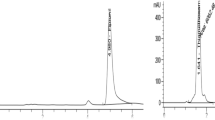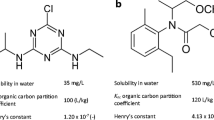Abstract
Understanding pesticide foliar washoff is important in pest management, in development of integrated management systems, and in environmental modeling. This study was conducted to determine the effect of elapsed time between spray application and initial rainfall on insecticide washoff from foliage. Azinphosmethyl and fenvalerate were applied to mature cotton plants as tank-mixed emulsifiable concentrates with a water carrier. DT50s (50% disappearance time) for azinphosmethyl and fenvalerate were 3.9 and 237 h, respectively. Simulated rain (51 mm in 1 h) was applied to the cotton plants at times ranging from 2 to 146 h after insecticide application to determine washoff characteristics for both compounds. Residues of both insecticides became increasingly resistant to wash-off with increasing time interval between insecticide application and initial rainfall, e.g., about 95% of the plant Xload washed off 2 h after application, whereas at 146 h <50% washed off. The mean amounts of both insecticides washed from the plants decreased with time and were related to the mean plant loads. The results of this study show that foliar pesticide application should be delayed when rain is imminent.
Similar content being viewed by others
References
Behrens R, Elakkad MA (1981) Influence of rainfall on the phytotoxicity of foliarly applied 2,4-D. Weed Sci 29:349–355
Bryson CT (1987) Effects of rainfall on foliar herbicides applied to rhizome Johnsongrass. Weed Sci 35:115–119
Estesen BJ, Buck NA, Ware GW (1979) Dislodgable insecticides residues on cotton foliage: Permethrin, curacron, fenvalerate, sulprofos, decis, and endosulfan. Bull Environ Contam Toxicol 22:245–248
Kudsk K (1989) Herbicide rainfastness on indoor and outdoor pot-grown plants. Aspects Applied Biol 21:133–134
Linscott DL, Hagin RD (1968) Effects of two environmental factors on removal of 2,4-DB from forage. Weed Sci 16:114–116
McDowell LL, Willis GH, Smith S, Southwick LM (1985) Insecticide washoff from cotton plants as a function of time between application and rainfall. Trans Am Soc Agric Eng 28:1896–1900
—, —,, Southwick LM, Smith S (1984) Methyl parathion and EPN washoff from cotton plants by simulated rain. Environ Sci Technol 18:423–427
—, —, —, — (1987) Fenvalerate wash-off from cotton plants by rainfall. Pestic Sci 21:83–92
—, —, —, — (1991) Interception and persistence of parathion and fenvalerate on cotton plants as a function of application method. Pestic Sci 33:271–279
Meyer LD, Harmon WC (1979) Rainfall simulator for erosion research on row sideslopes. Trans Am Soc Agric Eng 22:100–103
Nemac SJ, Atkinson PL (1969) Effects of simulated rain and dew on the toxicity of certain ultra-low-volume insecticidal spray formulations. J Econ Entomol 62:71–73
Nord JC, Pepper WD (1991) Rainfastness of insecticide deposits on loblolly pine foliage and the efficacy of adjuvants in preventing washoff. J Entomol Sci 26:287–298
Pick FE, van Dyk LP, de Beer PR (1984) The effect of simulated rain on deposits of some cotton pesticides. Pest Sci 15:616–623
Smith S, Reagen TE, Flynn JL, Willis GH (1983) Azinphosmethyl and fenvalerate runoff loss from a sugarcane-insect IPM system. J Environ Qual 12:534–537
U.S. Department of Commerce, Weather Bureau, Hydrologic Services Division, Cooperative Studies Section (1955) Rainfall intensity-duration-frequency curves. Technical Paper 25. U.S. Gov Printing Office, Washington, DC, 53 pp
Wauchope RD, Buttler TM, Hornsby AG, Augustijn-Beckers PWM, Burt JP (1992) The SCS/ARS/CES pesticide properties database for environmental decision-making. Rev Environ Contam Toxicol 123:1–155
Willis GH, McDowell LL (1987) Pesticide persistence on foliage. Rev Environ Contam Toxicol 100:23–73
—, —,, Smith S, Southwick LM (1986) Permethrin washoff from cotton plants by simulated rainfall. J Environ Qual 15:116–120
—, —, —, — (1991) Application method effects on methyl parathion and permethrin deposition and persistence on cotton plants. J Agric Food Chem 39:408–411
—, —, —, — (1992a) Foliar washoff of oil-applied malathion and permethrin as a function of time after application. J Agric Food Chem 40:1086–1089
--, --, --, --(1993) Permethrin and sulprofos washoff from cotton plants as a function of time between application and initial rainfall. J Environ Qual (in press)
—, —,, Southwick LM, Smith S (1992b) Washoff of ULV-oil-applied insecticides from cotton plants as a function of time between application and rainfall. J Environ Qual 21:373–377
Author information
Authors and Affiliations
Rights and permissions
About this article
Cite this article
Willis, G.H., McDowell, L.L., Southwick, L.M. et al. Azinphosmethyl and fenvalerate washoff from cotton plants as a function of time between application and initial rainfall. Arch. Environ. Contam. Toxicol. 27, 115–120 (1994). https://doi.org/10.1007/BF00203896
Received:
Issue Date:
DOI: https://doi.org/10.1007/BF00203896




